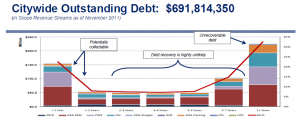Last year around this time, the city announced it was “getting tough on users of its services who have racked up nearly $1 billion in unpaid fines and fees, unveiling an aggressive collection program that is expected to make frequent use of litigation.” The Chron has an update on how that is going.
A city analysis of delinquent bills revealed that nearly 70 percent of the debt is more than 2 years old. The older a debt gets, industry experts say, the less likely it is that it will be collected. People die, move or even forget about bills past due as time goes on.
“There’s no write-off of these older debts,” Bruce Haupt, the city’s deputy assistant finance director, told the City Council’s Budget and Fiscal Affairs Committee. “It’s just in terms of setting realistic expectations of what is potentially out there to really pursue, it’s really the last two years’ worth of debt.”
According to the Finance Department, that represents about $210 million.
[…]
[T]he $295 million the city is owed in unpaid ambulance rides alone will be difficult to collect because many of the debtors are uninsured, indigent people. The city’s leverage to collect $25 million in red-light camera fines has been limited in part by the county tax assessor’s refusal to deny vehicle registration renewals to red-light scofflaws.
Finance director Kelly Dowe said he expects collections to increase as the city changes the way it evaluates its debt collectors. Currently, the city evaluates its collectors largely on how many contacts they make with debtors. Several of those collections contracts are up for renewal this year, and Dowe said the city intends to shift toward evaluating its debt collectors on how much money they brought in. The city also intends to improve its data management, Dowe said.
The city uses at least five different firms to collect bills for 13 departments. The departments’ databases are not integrated. Currently, there is no way of knowing, for example, if a delinquent property owner also has applied for a restaurant permit. The city also has stopped short of reporting many kinds of debt to credit bureaus to increase pressure on debtors.
Kind of a different tone this time around. Still, even with the reduced numbers, it’s worth the effort. If $210 million is the new target, that’s still a lot of money, and collecting even ten percent of it would make a big difference. If you look at this detailed presentation given to the city’s Budget & Fiscal Affairs Committee, you’ll see this on the Executive Summary page:
The project team is now moving into the implementation phase of the project focused on building sustainable processes to more
effectively manage collection efforts including:
1. Implementing specific activities to collect against outstanding debt
2. Implementing citywide practices that will improve the collection processes going forward including:
- Collection enforcement mechanisms such as Credit Bureau Reporting, Scofflaw, and Legal Action
- Citywide skip tracing capabilities to obtain correct contact information on City debtors
- Metrics for reporting on internal collections’ operations and external vendors
- Developing the infrastructure to support the reporting process, customer master data, and skip tracing
Implementing the above recommendations is expected to yield an incremental FY13 Budget impact of $9.3 MM
($8.6MM to General Fund).
Not too shabby. The Fiscal Responsibility page has other presentations from August through January, and I can tell you because I was looking on that page early yesterday morning for this kind of information that it was all (except for the presentation from August ) added during the day yesterday. Because none of that was there when I looked, and because the Chron story didn’t address the issue, I sent an inquiry to Finance Director Dowe to ask for a total on debt collection since this initiative was announced. Now we can see what they project, but I still can’t tell how much they’ve already taken in. I will let you know when I hear back from him.


there is only so many times the city can go to the same well.